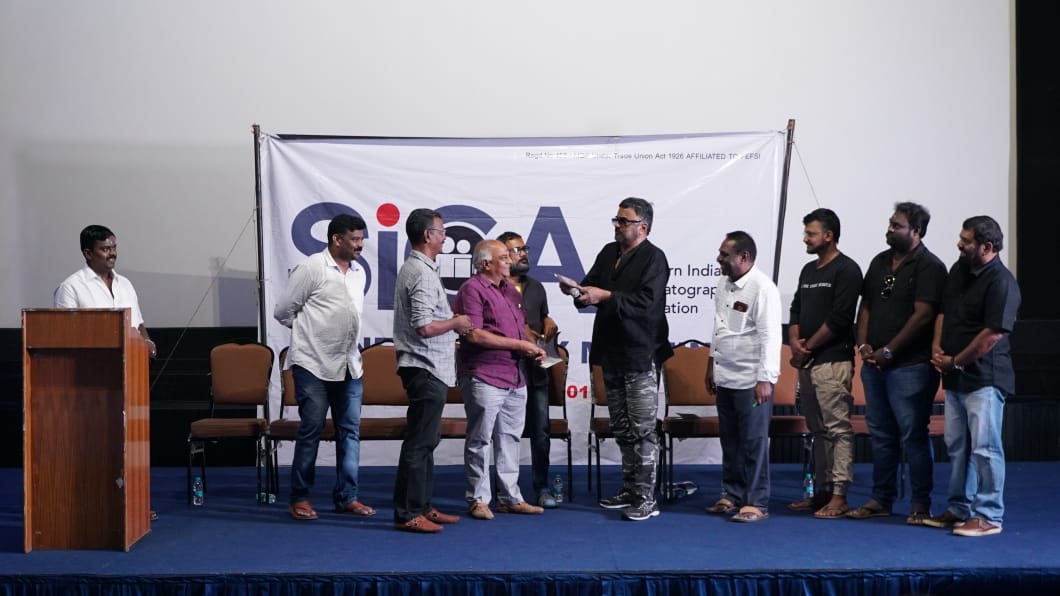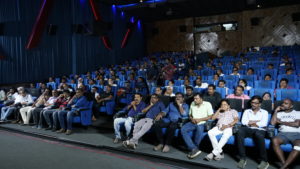
SICA AGM 2019
Sep 08 2019
SICA Annual general body meeting was conducted on Sunday 11th August 2019 at Prasad lab theatre, Chennai and important resolution were passed and approved by members.
This AGM had lots of important and progressive ideas, focus was given to bring SICA as a knowledge sharing platform, during registration of the event members were given printed handouts of Digital Cinematography short notes packed with technical information.

At the start of the event respects given to Cinematographer M.J.Radhakrishnan.
IMPORTANT RESOLUTION AT THE EVENT
SICA New membership amount will be increased with immediate effect as follows :- Junior – Rs.50,000(Fifty Thousand ) Associate – Rs.75,000/-(Seventy Five Thousand) and Active – Rs.1,00,000/- (One lakh).
Need for membership upgrade was passed at the meeting (Junior to Associate, Junior to Active, Associate to Active).
Death fund of Rs.2,00,000/- (Two lakhs) shall be given to members family irrespective to the cause of death (natural or unnatural).
Members who failed to pay yearly subscription for continuously 3 years are debarred and have to pay new fees structure to get the Membership again.
Resolution was passed and approved on subject of Cinematographers advised not to work with Non SICA members. If so strict action will be taken against Non Members and Cinematographers.
Cinematographers of both Film and Television who stand in for replacement have to get NOC (No Objection Certificate) from the previously working cinematographer and inform SICA office.

NEW BUILDING FOR SICA INITIATIVE

General Secretary Mr. B.Kannan said that the important mission of the Newly Elected body for second term is to have a own building for SICA.As a part of fund raising program he donated Rs.1 lakh to follow with SICA President Mr.P.C.Sreeram announcing Rs.3 lakhs, Executive committee members Mr.Ilamparuthi and Mr.Ekhambaram also said they will donate each Rs.1 lakh.
Mr.P.C.Sreeram said that for SICA building first let SICA Cinematographers start donating and let the news spread to inspire others to contribute without any compulsion.
Further Anand Cine Service Proprietor Mr.Anand came forward to donate Rupees One Crore to SICA which was highly appreciated.
Cinematographers Mr.Balasubramaniem, Mr.Natraj Subramaniam and Mr.Sevilo Raja also announced to donate money as their contribution to SICA building.
To sum up, it was just a beginning for all to donate.
SICA kindly request you all to contribute liberally to achieve our goals.
SICA SHORT TECHNICAL INFO GIVEN AT THE EVENT
Digital Cinematography : Process of recording moving images as Binary Numbers, that is recording images with the Digital Camera where images are stored in the memory card as 0,1
Sensor : Image Sensor Coverts photons into electrons.
Sensor Construction : Image Sensor is a solid state device which has photo diode as tiny pixel wells where light is charged into electric impulses. Sensor has many parts each perform different functions simultaneously
IR cut filter– blocks infra red rays
Low pass filter – regulates light frequency
Color filter array – responsible for color reproduction which has a mosaic pattern where red,green,blue color filters arranged where green has twice the values.
Micro lens – Allows light from omni direction to reach pixel wells.
Active pixel area– has photo receptor made up of silicon wafer which gets charged into electric signal proportional to light.
circuitry system– to amplify the signal charge created
ADC – Analog to digital convertor.
Types of Sensor – CCD & CMOS
CCD – Charged couple Device very popular type of sensor which was used earlier it has advantage of having global shutter which scans the image as a mechanical shutter used in film cameras.
CMOS- Complementary Metal Oxide Semi Conductor this the type of Sensor which is widely used in modern digital cameras, major reason is it is cost effective, uses less power consumption and ability to get bigger size sensor, it uses rolling shutter where the image is processed simultaneously that enables for high speed cinematography.
Sensor Sizes
Full frame- the size of the sensor equates to 35mm format its dimension is 36mm wide and 24mm height
APS -C – the size equates to super 35mm format it has a crop factor of 1.5 to 1.7 compared to full frame APS-C stands for advanced photo system -c most of the Digital Cinema Camera Sensor size falls into this category
APS-H – the size equates to super 35mm format it has a crop factor of 1.3 compared to full frame APS-H stands for advanced photo system -H
Micro four thirds – the size of the sensor equates super 16mm format.
Above are the main sizes of Image Sensor there are few Sensor larger than Full frame that falls into large format cinematography like 65mm, Imax and Vista Vision.
Sensor size lesser than micro four thirds are used for special application cameras like Go pro action camera and many more special application to mobile phones.
Pixel– is a picture element , A pixel is the smallest unit of a digital image as we term Grain in a film.
One million pixels – mega pixel
Pixel pitch is the distance (usually in millimeters) between pixels. A pixel pitch is measured from the center of one pixel to the center of an adjacent pixel.
Resolution– Resolution refers to the number of pixels in an image. Resolution is sometimes identified by the width and height of the image.
Different types video resolution :- SD /HD /UHD
SD – stands for standard resolution, which has lesser pixel count of 720p
HD– stands for High Definition which has a resolution of 1280×720
FULL HD– has the resolution of 1920x 1080 pixels
2 k – 2048x 1080
4k – 4096x 2160
UHD – 3840 x 2160
5K – 5120X2880
6K -6144X 3072
8K UHD – 7680x 4320
8k – 8192 x 4320
Image processor – The image processing engine is most vital in the camera. The engine converts analog image information into Digital image thro various process. Image stabilization, ISO noise control, viewing images in electronically, auto focus, metering, processing raw data like wise many functions are done by Image processor.
Native ISO or Base sensitivity – is the standard ISO setting a camera sensor sensitivity is manufactured, technically full light well capacity of a sensor.
Dual NATIVE ISO – where camera has two native ISO where camera performs to the best at tested conditions, simple way to understand is each pixel will have dual circuitry system ..for example some cameras have native ISO 800 & 3200.
CJ Rajkumar
Author/Cinematographer
